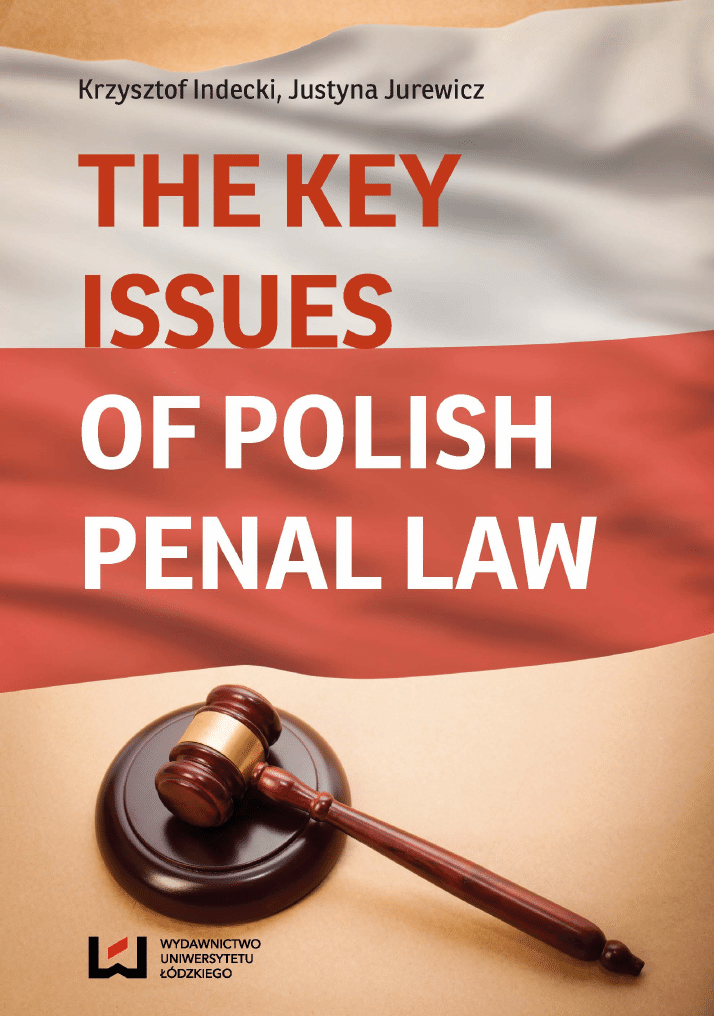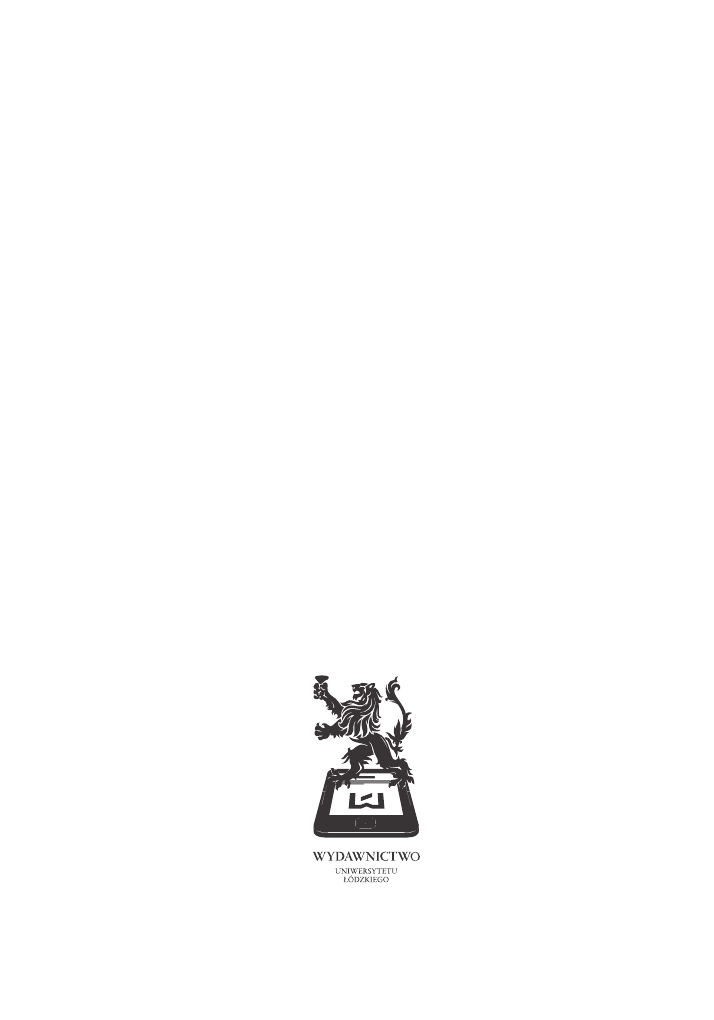

Krzysztof Indecki, Justyna Jurewicz – Uniwersytet Łódzki, Wydział Prawa i Administracji
Katedra Prawa Karnego Międzynarodowego, 90-232 Łódź, ul. Kopcińskiego 8/12
RECENZENT
Barbara Kunicka-Michalska
SKŁAD KOMPUTEROWY
AGENT PR
PROJEKT OKŁADKI
Stämpfli Polska Sp. z o.o.
Zdjęcie na okładce: © Shutterstock.com
© Copyright by Uniwersytet Łódzki, Łódź 2014
Wydane przez Wydawnictwo Uniwersytetu Łódzkiego
Wydanie I. W.06698.14.0.K
ISBN 978-83-7969-430-3
Wydawnictwo Uniwersytetu Łódzkiego
90-131 Łódź, ul. Lindleya 8
www.wydawnictwo.uni.lodz.pl
e-mail: ksiegarnia@uni.lodz.pl
tel. (42) 665 58 63, faks (42) 665 58 62
Krzysztof Indecki, Justyna Jurewicz – Uniwersytet Łódzki, Wydział Prawa i Administracji
Katedra Prawa Karnego Międzynarodowego, 90-232 Łódź, ul. Kopcińskiego 8/12
RECENZENT
Barbara Kunicka-Michalska
SKŁAD KOMPUTEROWY
AGENT PR
PROJEKT OKŁADKI
Stämpfli Polska Sp. z o.o.
Zdjęcie na okładce: © Shutterstock.com
© Copyright by Uniwersytet Łódzki, Łódź 2014
Wydane przez Wydawnictwo Uniwersytetu Łódzkiego
Wydanie I. W.06698.14.0.K
ISBN 978-83-7969-430-3
e-ISBN 978-83-7969-967-4
Wydawnictwo Uniwersytetu Łódzkiego
90-131 Łódź, ul. Lindleya 8
www.wydawnictwo.uni.lodz.pl
e-mail: ksiegarnia@uni.lodz.pl
tel. (42) 665 58 63, faks (42) 665 58 62
Druk i oprawa: Quick Druk

CONTENTS
Introduction
7
G
eneral
P
art
11
1. Principles
11
2. Offence
18
3. Element excluding offence. Circumstances excluding or reducing the degree of fault
23
4. Forms of committing an offence
31
5. Concurrence of statutory provisions and concurrence of offences
39
6. Imposition of penalties
43
7. Penalties, penal measures and preventive measures
51
7.1. Penalties
51
7.2. Penal measures
54
7.3. Preventive measures
66
S
Pecial
P
art
69
Conclusions
111
Selected bibliography
113

Introduction
Krzysztof Indecki
The first Polish Penal Code was adopted in 1932
1
, the second one in 1969
2
,
and the third one in 1997
3
.
The Code of 1932 was a symbol of the re-establishment of Polish independ-
ence after more than 120 years of partition
4
.
After World War II the 1932 Penal Code did not ensure the protection of the
newly formed State’s political and economic interests. It did not correspond to the
conditions of the new political, social, and economic system as well as cultural
life; in particular, it did not guarantee the prosecution of the Nazi offences
5
.
After World War II many laws and decrees that were aimed at prosecuting
such offences were passed.
The process of creating penal law at that time can be divided into three stages:
– the first one, which covered the years between 1944 and 1954, is represent-
ed by legislative efforts to combat fascism and to punish war criminals as well as
to censure those Polish citizens who had collaborated with the Nazis
6
;
1
Rozporządzenie Prezydenta Rzeczypospolitej z 11 VII 1932 r., Dz.U., nr 60, poz. 571, ze zm.
(Journal of Laws, no. 60, item 571, as amended).
2
Ustawa z 19 IV 1969 r., Dz.U., nr 13, poz. 94 ze zm. (Journal of Laws, no. 13, item 94, as
amended).
3
Ustawa z 6 VI 1997 r., Dz.U., nr 88, poz. 553 ze zm. (Journal of Laws, no. 88, item 553, as
amended).
4
See: J. Bafia, Penal Law, [in:] L. Kurowski (ed.), General Principles of Law of the Polish
People’s Republic of Poland, Warsaw 1984, p. 277.
5
See: ibidem.
6
See for example: dekret z 31 VII 1944 r. o wymiarze kary dla faszystowsko-hitlerowskich
zbrodniarzy winnych znęcania się nad ludnością cywilną i jeńcami oraz dla zdrajców Narodu Pol-
skiego, Dz.U. 1946, nr 69, poz. 377, Dz.U. 1947, nr 65, poz. 390, Dz.U. 1948, nr 18, poz. 124, Dz.U.
1949, nr 32, poz. 238 (Journal of Laws of 1946, no. 69, item 377, Journal of Law of 1948, nr 48, item,
124, Journal of Laws of 1949, no. 32, item 238); art. 1
st
of the decree is still force in relation to the
genocide (see: art. 5, sec. 1 of the law of 6 VI 1997 Przepisy wprowadzające kodeks karny, Dz.U.,
nr 88, poz. 554 i nr 160, poz. 1083; Dz.U. 1998, nr 113, poz. 715 – Journal of Laws, no. 88, item 554
and no. 160, item 1083, Journal of Laws of 1998, no. 113, item 715), Kodeks karny Wojska Polskiego,
dekret z 23 IX 1944, Dz.U. 1957, nr 22, poz. 107, tekst jednolity (consolidated text: Journal of Laws of
1957, no. 22, item 107, dekret z 13 VI 1946 o przestępstwach szczególnie niebezpiecznych w okresie

8
– during the second one, which roughly covered the years 1955–1969, the
laws were improved and adapted to the system that was undergoing transforma-
tion as well as to the current needs of the fight against crime, in particular eco-
nomic crime
7
;
– the third one started on 1 January 1970; after this date the Penal Code of
1969 and other very important laws, such as the Code of Criminal Procedure
8
and
the Executive Penal Code
9
, entered into force.
The Penal Code of 1969 concentrated on the so-called polarisation of respon-
sibility and limiting the disposition of the penalty of the deprivation of liberty in
favour of non-custodial penalties.
However, it is widely accepted in the literature that this idea was not imple-
mented satisfactorily
10
.
Therefore, penal law reform was undertaken at the end of the 1980s.
To this end, the Ministry of Justice appointed a special commission that was
to prepare a draft of proper amendments to the penal law.
Another commission was also established under the auspices of the “Solidar-
ity” movement.
As a result, two drafts of the Penal Code were published in 1981, i.e. the so-
called governmental and the so-called public one.
Both of these drafts were based on the same principles, i.e. the liberalisation
and rationalisation of penalties as well as the penal policy system and combating
offence by penal measures, and were aimed to ensure better protection of indi-
vidual rights (both of the wronged person and the perpetrator of an offence)
11
.
The State Council introduced martial law by the decree of 1981
12
. This de-
cree interrupted the process of penal reform until 1987.
odbudowy Państwa, tzw. Mały Kodeks Karny, Dz.U., nr 30, poz. 192 (Journal of Laws, no. 30, item
192). The Law contained provisions, unknown in the 1932 Penal Code: espionage, sabotage, illegal
possession of firearms and others. This act was modified a number of times; was repealed on 1 I 1970.
7
See for example: ustawa z 21 I 1958 r. o wzmożeniu ochrony mienia społecznego przed
szkodami wynikającymi z przestępstwa, Dz.U., nr 4, poz. 11, ustawa z 18 VI 1959 o odpowie-
dzialności karnej za przestępstwa przeciw własności społecznej, Dz.U., nr 36, poz. 228 (Journal
of Laws, no. 36, item 228), ustawa z 13 VII 1957 o zwalczaniu spekulacji i ochronie interesów na-
bywców oraz producentów rolnych w obrocie handlowym, Dz.U., nr 39, poz. 171 (Journal of Laws,
no. 39, item 171); ustawa z 27 IV 1956 o warunkach dopuszczalności przerywania ciąży, Dz.U.,
nr 12, poz. 61; ustawa z 10 XII 1959 o zwalczaniu alkoholizmu, Dz.U., nr 69, poz. 434 (Journal
of Laws of 1959, no. 12, item 61), ustawa z 22 V 1958 o zaostrzeniu odpowiedzialności karnej za
chuligaństwo,
Dz.U., nr 34, poz. 153 (Journal of Laws, no. 34, item 61).
8
Ustawa z 6 VI 1969, Dz.U., nr 89, poz. 555 ze zm. (Journal of Laws of 1969, no. 89, item 555,
as amended).
9
Ustawa z 6 VI 1969, Dz.U., nr 90, poz. 557 (Journal of Laws of 1969, no. 90, item 557).
10
See: A. Marek, Prawo karne. Zagadnienia teorii i praktyki, Warszawa 1997, s. 18, 19, see also:
Projekt Kodeksu karnego. Uzasadnienie, Warszawa 1968, p. 1.
11
See: ibidem, p. 19.
12
See: Dekret z 12 XII 1981 o stanie wojennym, Dz.U., nr 29, poz. 154 (Journal of Laws of
1981, no. 29, 154).

9
The commissions that had been appointed to carry out the reforms of penal law
began work under new political and ideological conditions
13
.
During this period certain changes were made to penal law.
The most important among them were the following:
a) repealing art. 194 of the Penal Code that penalised the abuse of freedom
of conscience and confession to the detriment of the Polish People’s Republic
14
;
b) repealing art. 282, which penalised public incitement to disobedience to or
acting against a law or regulation that was adopted by a state authority
15
;
c) abolishing an additional penalty of property confiscation as well as of com-
mitment to a social adjustment centre for recidivists
16
;
d) determining the amount of a fine based on the State’s economic situation
and the level of inflation
17
;
e) making amendments concerning the conditions under which the termina-
tion of pregnancy was permitted (arts. 149a, 156b and 157 of the Penal Code)
18
;
f) repealing acts that dealt with the protection of economic turnover
19
;
g) repealing a range of additional penal acts
20
;
h) amending the Penal Code by the statute of 12 July 1995 (these changes
were referred to as “a small amendment”)
21
.
After the political and legal changes the work on the new Penal Code was
carried out based on the governmental draft.
The first version of the new Penal Code was published in 1991. The final ver-
sion of the draft Penal Code was issued in 1994 with an explanatory statement.
The bill was brought before the Sejm in 1995.
13
See: ibidem.
14
See: ustawa z 17 V 1989 r. o stosunku państwa do Kościoła katolickiego, Dz.U., nr 29, poz. 154
(Journal of Laws, no. 29, item 154).
15
See: ustawa z 29 V 1989 o zmianie niektórych przepisów prawa karnego, Dz.U., nr 34, poz. 180
(Journal of Laws, no. 34, item 180).
16
See: ustawa z 23 II 1990 o zmianie kodeksu karnego i niektórych innych ustaw, Dz.U., nr 14,
poz. 24 (Journal of Laws, no. 14, item 24).
17
See: ustawa z 28 II 1992 o zmianie niektórych przepisów prawa karnego, prawa o wykro-
czeniach i o postępowaniu w sprawach nieletnich, Dz.U., nr 24, poz. 101 (Journal of Laws, no. 24,
item 101).
18
See: ustawa z 7 I 1993 o planowaniu rodziny, ochronie płodu ludzkiego i warunkach dopusz-
czalności przerywania ciąży, Dz.U., nr 17, poz. 78 (Journal of Laws, no. 17, item 78, as amended).
19
See: ustawa z 12 X 1994 r. o ochronie obrotu gospodarczego i zmianie niektórych przepisów
prawa karnego, Dz.U., nr 126, poz. 615 (Journal of Laws, no. 126, item 615).
20
See for example: prawo bankowe, tekst jednolity: Dz.U. 1994, nr 72, poz. 359 z późn. zm.
(Journal of Laws of 1994, no. 72, item 359, as amended), prawo o publicznym obrocie papierami
wartościowymi i funduszach powierniczych, tekst jednolity: Dz.U. 1994, nr 58, poz. 239 z późn. zm.
(consolidated text: Journal of Laws of 1994, no. 58, item 239, as amended).
21
See: ustawa z 12 VII 1995 r. o zmianie przepisów Kodeksu karnego i Kodeksu karnego
wykonawczego oraz o podwyższeniu dolnych i górnych granic grzywien i nawiązek w prawie kar-
nym, Dz.U., nr 95, poz. 475 (Journal of Laws, no. 95, item 475); also: L. Gardocki, Najnowsze zmiany
w kodeksie karnym, Państwo i Prawo 1995, 12.

10
The 1997 Penal Code came into force on 1 September 1998; it represents the
premises on which the Republic of Poland is based.
In contrast to the former Penal Code, the new Penal Code is based on a new
axiology that is adequate for democratic rule, i.e. under which penal law is a tool
for protecting the fundamental human values, and not a political tool
22
.
The main task of the Penal Code of 1997 is to protect the dignity of human
beings, including wronged persons
23
.
This objective was not questioned in the jurisprudence and it was manifested,
for example, in a tendency towards liberalising the system of sanctions
24
.
The code was also modified so as to meet European standards (e.g. the death
penalty was abolished)
25
.
The Penal Code of 1997 comprises three main parts: the general part (arts.
1–116), the special part (arts. 117–316) and the military part (arts. 317–363). Minor
offences were left out from this code and regulated separately, i.e. by the Code of
Minor Offences, thus continuing the trend that had begun with the Penal Code of
1969
26
.
22
See: Uzasadnienie do Projektu Kodeksu Karnego, wkładka do Państwa i Prawa 1994, 3, p. 3.
23
See: ibidem.
24
See: A. Marek, Prawo karne, C.H. Beck 2011, p. 22.
25
See: A. Grzelak, Unia europejska a prawo karne, Warszawa 2002, p. 99 ff.; A. Marek, Pra-
wo..., p. 23. H. H. Jescheck, Część ogólna projektu polskiego KK w świetle prawnoporównawczym,
Państwo i Prawo 1992, 12, p. 27.
26
Compare: K. Indecki, The Main Features and Principles of the Polish Penal Law, Teise 2003,
no. 48.

G
eneral
P
art
1. Principles
Penal law is based on principles which are rooted in the Constitution and which
are aimed to protect civil rights. These rights must be respected also when a citizen
is prosecuted for committing an offence.
Polish penal law is based on the following principles: nullum crimen sine
lege, nulla poena sine lege, nullum crimen sine culpa, lex retro non agit, the prin-
ciple of criminal responsibility for an act, the principle of individual and personal
liability, and the principle of humanitarianism.
These principles create the so-called complex of the principles of penal re-
sponsibility
27
and define the structure of an offence and sometimes also the axi-
ological assumptions of penal law.
In the process of formulating the 1997 Penal Code some of these principles were
partly modified (cf., e.g. art. 1 of the 1969 Penal Code and art. 1 of the 1997 Penal
Code). Certain new principles were also added, such as the principle of humanitari-
anism.
Currently, nullum crimen sine lege is the basic principle, which is closely con-
nected with the guarantee function of penal law. The aim of this principle is to ensure
the protection of citizens against any act committed by the organs of the State if they
were to be used for the purpose of political repression by using penal law tools.
The foundation of this principle was created during the period of the Enlighten-
ment.
The nullum crimen sine lege principle was clearly formulated for the first time
in art. 8 of the Declaration of the Rights of Man and of the Citizen dated 1789
28
.
Starting with A. Feuerbach’ theory, this principle is treated as the most important
27
See: R. Dębski, Uwagi o konstytucyjnym ujęciu zasady nullum crimen sine lege w polskim
porządku prawnym, [in:] Nauki penalne wobec problemów współczesnej przestępczości. Księga ju-
bileuszowa z okazji 70. rocznicy urodzin Profesora Andrzeja Gaberle, Warszawa 2007, p. 91 ff.;
B. Kunicka-Michalska, Zasada nullum crimen sine lege w projekcie kodeksu karnego w świetle
norm międzynarodowych, [in:] S. Waltoś (red.), Problemy kodyfikacji prawa karnego. Księga ku czci
M. Cieślaka, Kraków 1993, p. 55 ff.
28
See: http://www.historyguide.org/intellect/declaration.html. Art. 8 states: “8. The law ought
only to establish penalties that are strict and obviously necessary, and no one can be punished except
in virtue of a law established and promulgated prior to the offense and legally applied”.

12
rule of the continental penal judicature and the main component of the concept of
a State under the rule of law
29
.
Moreover, this principle has an international dimension because it is recognised
as one of the fundamental human rights (see art. 11 of the Universal Declaration of
Human Rights and art. 15 of the International Covenant on Civil and Political Rights).
In the Constitution of the Republic of Poland of 1997, which refers to the
March Constitution of 1921
30
and the April Constitution of 1935
31
, the nullum
crimen sine lege principle was elevated to the rank of a constitutional principle.
Art. 42.1 of the Constitution of the Republic of Poland of 1997 states that:
“Only a person who has committed an act prohibited by a statute in force at the
moment of commission thereof, and which is subject to a penalty, shall be held
criminally responsible”.
This provision is addressed directly to the legislator, and not to the State’s or-
gans that enforce the law. It contains a directive according to which the issue of crim-
inal responsibility falls exclusively within the competence of the legislative branch
32
.
The nullum crimen sine lege principle has also been introduced into art. 1,
sec. 1. of the Penal Code. This provision is almost a literal repetition of art. 42.1
of the Constitution of the Republic of Poland.
Art. 1, sec. 1. of the Code is addressed to the State’s organs that enforce the
law, not to the legislator. Therefore, it is necessary to clearly distinguish the nullum
crimen sine lege principle’s functions that arise from the Constitution from the
functions that this principle fulfils as a legal norm.
As a result of a clear distinction between the spheres of making laws from the
sphere of enforcing laws, the violation of the nullum crimen sine lege principle by
the legislator, for example, through enacting penal law with retroactive effect, is,
as a rule, inadmissible and may create the basis for checking the compliance of
such a law with art. 42.1 of the Constitution of the Republic of Poland
33
.
The first recommendation for the legislator is that the classification of par-
ticular offences contrary to the nullum crimen sine lege scripta principle is to be
prohibited.
It is clear that only written, i.e. statutory, law, that is, acts or other legal instru-
ments that are passed by a legislative body (statutes) may be the source of norms in
penal law
34
.
29
K. Indecki, A. Liszewska, Prawo karne materialne. Nauka o przestępstwie, karze i środ-
kach penalnych, Dom Wydawniczy ABC 2002, p. 32.
30
See: Konstytucja Rzeczypospolitej Polskiej [marcowa], Dz.U. 1921, nr 44, poz. 267 (Journal
of Laws of 1921, no. 44, item 267).
31
See: Ustawa konstytucyjna z 23 kwietnia 1935 [kwietniowa], Dz.U., nr 30, poz. 227 (Jour-
nal of Laws, no. 30, item 227).
32
K. Indecki, A. Liszewska, op.cit.
33
See: Konstytucja Rzeczypospolitej Polskiej z 2 kwietnia 1997, Dz.U., nr 78, poz. 483 ze zm.
(Journal of Laws, no. 78, item 483 with amended); see: K. Indecki, A. Liszewska, op.cit., p. 31.
34
See: A. Zoll, [in:] K. Buchała, A. Zoll (red.), Kodeks karny Część ogólna. Komentarz, Zaka-
mycze 1998, p. 27.
Wyszukiwarka
Podobne podstrony:
In the Key Chords of Dawn
Answer Key Middle of the book Tests AB
3 The stereotypical image of the Polish
22 The climate of Polish Lands as viewed by chroniclers, writers and scientists
Arancha THE CHILDREN OF THE KEY
Answer Key End of the book Tests AB
Answer Key Middle of the book Tests? (2)
Answer Key End of the book Tests? (2)
Russian Special Forces Issues of Loyalty, Corruption and the Fight Against Terror
Ecumeny and Law 2015 Vol 3 Welfare of the Child Welfare of Family Church and Society
Eliphas Levi The Key of the Mysteries
Linnea Sinclair Rhapsody In The Key of Death
więcej podobnych podstron


